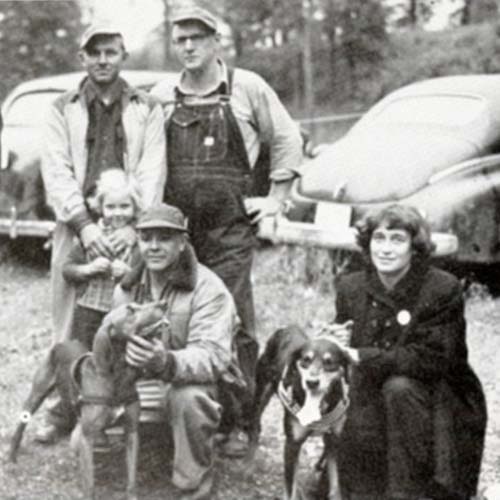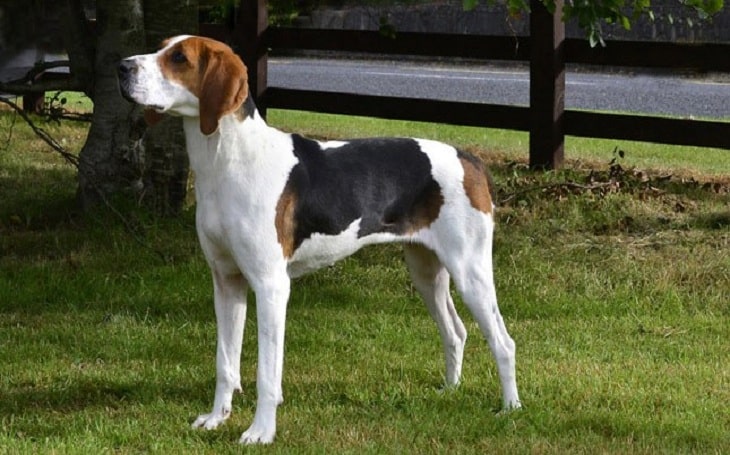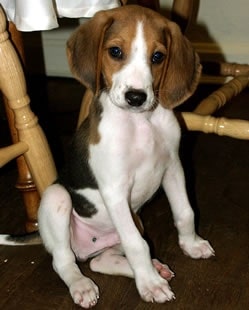Treeing Walker Coonhound Dog Breed Information
| Country of Origin | United States |
| Nicknames and Other Names | TWC, Walker |
| Scientific Name | Canis lupus familiaris |
| Breed Type | Purebred |
| Group | Hound Group |
| Bred For | Hunting raccoons |
| Size | Medium-sized |
| Recognized By | UKC, AKC |
| Life Span | 12-13 years |
| Ideal Weight | 50-70 pounds (male and female) |
| Ideal Height | Male: 22-27 inches Female: 20-25 inches |
| Fur Type | Short and dense |
| Common Colors | Tri-colored, White, Black |
| Markings | Blanket-Back, Black Spots, Tan Spots, White markings, Tan Trim |
| Availability | Moderately available |
| Achievements | “People’s Choice” |
| Suitable for Apartments | No |
| Used in World War | No |
| Most Similar To | Bluetick Coonhound |
The Treeing Walker Coonhound, which is also known as English Coonhound is a medium-sized dog used for treeing and hunting. It is a highly active and energetic dog breed that needs regular exercise.
This Coonhound is best suited in a house with an owner that is active and can take it out for walking, hiking, or running. It is not suited for apartment life and needs a house with a yard.
The Treeing Walker Coonhound has a board skull with the long and narrow muzzle. Their ears are of medium length which is set slightly low and hangs towards the muzzle. The eyes are large, set apart with an expression of a hound. They have a smooth and dense coat that is short.
Origin and History
The Treeing Walker Coonhound descended from the English Foxhound that was brought to America in colonial times. The name Treeing Walker Coonhound has its own history. “Treeing” means to chase its quarry until the quarry climbs up in the tree and the hound stay below barking.
The word Walker refers to Thomas Walker of Virginia, who was the important figure for this breed early development. “Coonhound” means the hound that is developed to tree raccoons and even bigger game.

Image Source: AKC
The United Kennel registered the Treeing Walker Coonhound as Walkers in 1945 but changed the name to Treeing Walker later. The American Kennel Club recognized this breed in 2012 as the member of the Hound Group.
Is Treeing Walker Coonhound Child-Friendly?
The Treeing Walker adores and tolerates children, therefore, you can say that it is a child-friendly dog. They like to play with kids and are protective of them.
With the energy level that matches with kids, it can make a great playmate for them. Playtime with children should be supervised as small kids might play rough and injure your dog.

Image Source: Instagram-@fitz_theshitz
Temperament, Behavior, and Personality
Temperament: The Treeing Walker has a friendly temperament but is suspicious of strangers. They do not trust strangers easily and you have to introduce them with new guest properly so they are welcoming of them. They make a great watchdog as they are very vocal and will bark to warn you of any strange activities going around.
Behavior: The Treeing Walker has a strong desire to chase small animals and even kill some time. If they catch any interesting scent, they will wander off to catch the prey. Therefore, keep them in a fenced yard so it wants to go chasing your neighbor’s cats.
Personality: The Treeing Walker has a smart and courteous personality. It is very smart and is able to learn new things quickly. They love their family and also loves to be involved in family activities. therefore, they make an excellent companion for a family.
Trainability
Training Treeing Walker Coonhound is mildly easy as they are smart and are quick to learn new commands. They are an independent dog who has a mind of their own. Therefore, they do not easily listen to you as you try to train them.
So, it is necessary to develop a firm leadership at an early age. Positive methods of training are best to motivate and encourage them.
Facts
- The Treeing Walker Coonhound is called ‘the people’s choice’ among all coonhound breeds.
- It ranks 137 of 193 American Kennel Club registered breed (as of April 2019)
- It was developed when the dog name Tennessee Lead was crossed with Walker Foxhound.
Health Issues
| General Health | Healthy |
| Common Health Issues | Bloat, Hip Dysplasia, Skin Diseases, Work-related Injuries, Ear Infection, Polyradiculoneuritis |
| Hypoallergenic | No |
| Vaccination Required | Canine Parvovirus, Rabies, Canine Distemper, Canine Parainfluenza, Kennel Cough, Leptospirosis, Canine Coronavirus |
| Shedding | Moderate Shedder |
| Drooling | Low Drooler |
| Grooming | Effortless and Minimal Grooming Required |
| Weight Gain Potential | Average |
| Separation Anxiety | Moderate Chance |
| Allergies | Skin Allergy |
| Diets and Supplements | Protein: 28% Fat: 8% Glucosamine Digestive Enzymes Omega-3 and 6 Fatty Acids |
The Treeing Walker Coonhound is generally a healthy breed with a life expectancy of 12-13 years. However, it can face a few health conditions during those years. Below is the possible health condition that it might face.
- Ear Infection: As a hunting dog and a scent hound, the Treeing Walker Coonhound is prone to ears infection. While following its prey, it carries much dirt in its ears as it bends to follow the scent. It will carry dirt in the ears and it can cause ears infection. Therefore, the ears should be cleaned often to prevent the infection.
- Paralysis: Paralysis is common in Coonhound. The exact reason behind this cause is still unknown but it is known that the raccoon’s bite causes the paralysis. It is said that not all the dogs that are bitten by the raccoons get the paralysis. Only a few face this situation and it is not toxin if treated timely.
Colors
The Treeing Walker Coonhound comes in following colors and markings according to American Kennel Club:
- Black
- Tri-colored
- White
- Black Spot
- Black Spot, Tan Trim
- Tan Spot
- Saddle Back
- White Markings
- Tan Trim
- Blanket-Back
Puppies

Image Source: pinterest 
Image Source: dogs and dog advice
Height and Size: The average height of the male Treeing Walker Coonhound is between 22-27 inches and the female is between 20-25. The average weight is between 50-70 pounds.
Cost: The average cost of the Treeing Walker Coonhound is between $400-$600 USD.
Similar Dog Breeds to Treeing Walker Coonhound
Visit Doglime for more information about dog breeds history, behavior, puppies, and training.
Tags












